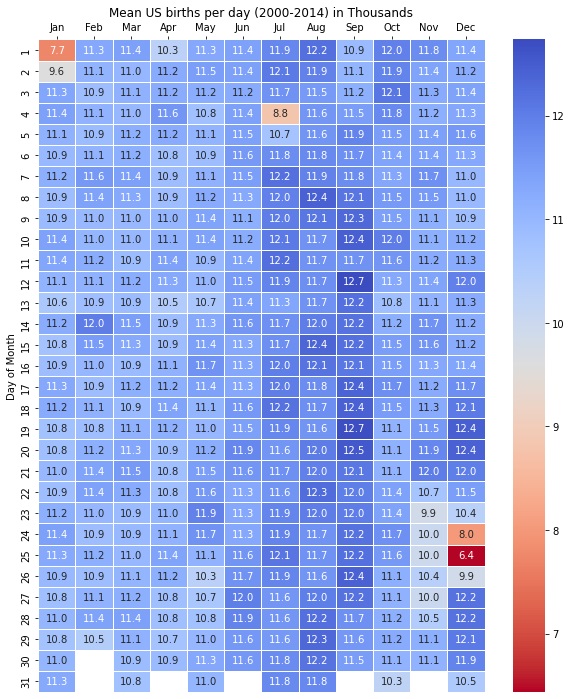Don't forget the weekdays. The total births in the dataset by weekday are:
SUN |||||||||||||||||||||||| 5886889
MON ||||||||||||||||||||||||||||||||||||| 9316001
TUE ||||||||||||||||||||||||||||||||||||||||| 10274874
WED |||||||||||||||||||||||||||||||||||||||| 10109130
THU |||||||||||||||||||||||||||||||||||||||| 10045436
FRI ||||||||||||||||||||||||||||||||||||||| 9850199
SAT |||||||||||||||||||||||||| 6704495
The color scale hugely amplifies minor differences, see my other comment. In the dataset, 15 years (2000-2014) are represented and the weekly cycle is therefore present. This could have been mitigated by using a 28-year dataset. Here is how often each month started on a given day in the dataset. We don't have colored text so I used emoji.
| 01/ | JAN | FEB | MAR | APR | MAY | JUN | JUL | AUG | SEP | OCT | NOV | DEC |
|---|---|---|---|---|---|---|---|---|---|---|---|---|
| SUN | 2➖ | 2➖ | 1🔻 | 3⚠️ | 2➖ | 3⚠️ | 3⚠️ | 2➖ | 2➖ | 2➖ | 1🔻 | 2➖ |
| MON | 2➖ | 1🔻 | 2➖ | 2➖ | 2➖ | 1🔻 | 2➖ | 2➖ | 3⚠️ | 3⚠️ | 2➖ | 3⚠️ |
| TUE | 3⚠️ | 3⚠️ | 2➖ | 3⚠️ | 3⚠️ | 2➖ | 3⚠️ | 2➖ | 1🔻 | 2➖ | 2➖ | 1🔻 |
| WED | 2➖ | 2➖ | 2➖ | 1🔻 | 2➖ | 2➖ | 1🔻 | 3⚠️ | 2➖ | 3⚠️ | 2➖ | 2➖ |
| THU | 2➖ | 2➖ | 3⚠️ | 2➖ | 3⚠️ | 2➖ | 2➖ | 2➖ | 2➖ | 1🔻 | 3⚠️ | 2➖ |
| FRI | 1🔻 | 3⚠️ | 2➖ | 2➖ | 1🔻 | 3⚠️ | 2➖ | 3⚠️ | 2➖ | 2➖ | 2➖ | 2➖ |
| SAT | 3⚠️ | 2➖ | 3⚠️ | 2➖ | 2➖ | 2➖ | 2➖ | 1🔻 | 3⚠️ | 2➖ | 3⚠️ | 3⚠️ |
Here is how likely any date is to be Monday-Friday in the data (out of 15):
| How often Mon-Fri | JAN | FEB | MAR | APR | MAY | JUN | JUL | AUG | SEP | OCT | NOV | DEC |
|---|---|---|---|---|---|---|---|---|---|---|---|---|
| 01/08/15/22/29 | 10🔻 | 11➖ | 11➖ | 10🔻 | 11➖ | 10🔻 | 10🔻 | 12⚠️ | 10🔻 | 11➖ | 11➖ | 10🔻 |
| 02/09/16/23/30 | 11➖ | 12⚠️ | 12⚠️ | 10🔻 | 11➖ | 11➖ | 10🔻 | 11➖ | 10🔻 | 10🔻 | 12⚠️ | 10🔻 |
| 03/10/17/24/31 | 10🔻 | 11➖ | 11➖ | 10🔻 | 10🔻 | 12⚠️ | 10🔻 | 11➖ | 11➖ | 10🔻 | 11➖ | 11➖ |
| 04/11/18/25 | 10🔻 | 10🔻 | 11➖ | 11➖ | 10🔻 | 11➖ | 11➖ | 10🔻 | 12⚠️ | 10🔻 | 11➖ | 12⚠️ |
| 05/12/19/26 | 11➖ | 11➖ | 10🔻 | 12⚠️ | 10🔻 | 11➖ | 12⚠️ | 10🔻 | 11➖ | 11➖ | 10🔻 | 11➖ |
| 06/13/20/27 | 12⚠️ | 10🔻 | 10🔻 | 11➖ | 11➖ | 10🔻 | 11➖ | 10🔻 | 11➖ | 12⚠️ | 10🔻 | 11➖ |
| 07/14/21/28 | 11➖ | 10🔻 | 10🔻 | 11➖ | 12⚠️ | 10🔻 | 11➖ | 11➖ | 10🔻 | 11➖ | 10🔻 | 10🔻 |
You can see for example that August 01/08/15/22/29 is 10-20% more likely to be a workday than other days, which corresponds to the extra births. Feb 29 cannot be read directly from this table; its value is 3 out of 4 (2000: Tue, 2004: Sun, 2008: Fri, 2012: Wed).
As for your question: every month has approximately the same strength of the weekly cycle, it's just that the prevailing colors in July-September show them the most. August's is more visible because it does not have the disrupting July 4 and September 11.
The color scale is terrible. Here is a more credible chart based on presumably the same data by Social Security Administration, covering 62,187,024 US births (2000-2014).

Meanwhile, the post's chart's actual Reddit OOP is u/plotset, an account made to shill PlotSet.com, a data visualization software.
They had this to say about the data:
This data represents 4,153,303 US-born babies only between 2000 and 2014.
Top 10 Most Common: Sep 12 (0.307%) Sep 19 (0.306%), Sep 20 (0.302%), Dec 19 (0.300%), Sep 10 (0.300%), Dec 20 (0.299%),Sep 18 (0.299%), Aug 8 (0.299%), Sep 26 (0.299%), Sep 17 (0.298%)
Top 10 Least Common: Dec 25 (0.155%), Jan 1 (0.186%), Dec 24 (0.193%), Jul 4 (0.212%), Jan 2 (0.231%), Dec 26 (0.238%), Nov 23 (0.238%), Nov 25 (0.240%), Nov 27 (0.241%), Nov 24 (0.241%)
Data Source: Kaggle.com/datasets/ayessa/birthday
Tools: PlotSet.com
Note that the "4,153,303" figure is bullshit. It is close to births per year but does not actually correspond to the sum in any of the 15 years, nor the average.
Also, neither chart normalizes by weekday: 3 of the years in question started on Tuesday and Saturday while only 1 on Friday, causing most of the variation that got amplified by OOP's terrible color range. (Because of leap years, I made a table of most common starting weekdays for each month; see my other comment. For example, one of the most common birthdays, August 15, was more often Wednesday or Friday than Saturday.) Without doing weird math, one can ensure the effect of weekdays is largely mitigated by using data from 28 consecutive years, which I believe can be pieced together from several good online sources but I'll be leaving that as an exercise to the reader.
Yes, you missed the joke. I know pawns can only move in one direction on the Y-axis.
Ja, ich habe damit ziemlich Mühe aufwendet, und natürlich auch Online-Quellen gebraucht. Ich frage aber besonders um den Inhalt der Sendung selbst - würde man das auch als Verherrlichung sehen? Damals hatte ein unbennanter deutscher Fernseher Interesse an Rechte, diese und andere Folgen auf Deutsch zu drehen, es ist aber nichts dabei herausgekommen. Deutscher Botschaft war aber absolut nicht begeistert.
Nein. Ich bin sicher, ich mache mindestens in 25% Fälle Deklinations- oder Konjugierungsfehler, trotzdem hat mich noch niemand korrigiert.
Wie findest du das Video? Es war Spaß, deutsche Untertitel zu erstellen. Leider wird Sendung "Česká soda", davon war es Teil, seit 1995 nicht mehr gedreht, denn ČT (gebührenfinanziertes Fernseher) auf politische Korrektur achtet.
Das klingt nett, ich finde das aber keine gute Idee. Die deutsche Kultur kenne ich noch nicht genug und brauche damit Bescheid, wenn ich über Grenzen trete.
Zum Beispiel ist in Tschechien, denn wir uns historisch für einen kleinen Nation in Hände mächtigere Staaten halten, Schwarzhumor als Bewältigungsstrategie populär. Man lacht über Nazi-Thematik, solange es sich klar um Satire handelt. Zum Beispiel wurde in 1994 die folgende Sendung nicht nur erlaubt, sondern auch gebührenfinanziert. Diese populäre Folge parodiert Werbungen für Waschmittel wie Palmex und Ariel, Tierfutter wie Whiskas usw.:
(Auslöserwarnung, natürlich; dreiste Qualität wegen 15MB-Begrenzung)
Also wenn ich dieses Bild am ersten Mal (r/ich_iel, September 2020) postiert habe, hatte ich keine Idee, dass man darüber nicht lachen würde.

Was ich statt Hochwählisse brauche, ist Kritik meiner Grammatik, damit ich künftige Fehler vermeiden kann.
I see what you did there.
"America" is indeed a proper noun. However, the phrase does not match the Regex expression \b(America)\b, where \b means a word boundary.
I'm already keeping track of the kings and rooks for castling reasons. Remembering whether any of the 16 pawns has moved is too overwhelming and turns IRL chess into a game of who can get away with the other player's bad memory.
The phrase does not contain the word "America". Look again.
standard North-American sized
Can we please standardize handling of dashes in multi-word adverb-adjective phrases?
Option 1: North American-sized (most common)
Option 2: North-American sized (as seen in the article)
Option 3: North-American-sized (makes most sense to me)
Option 4: North American sized (Edit: added based on @[email protected]'s comment)
Almost.
Here, I converted your image so that Cb and Cr (blue-complement and red-complement chroma) channels are constant, and only Y (luma) carries any image data, just like the flag.

Black and white cannot be reproduced unless you adjust chroma to center in those places or allow luma to span outside the 0-255 range.
yet no real use found for en passant
"can I have saturation?"
"yes but only on satur-day"

I know that Hebrew does not have that many lone vertical lines. It's a joke, and I was expecting someone to follow up on it by making up a funny "transcript".
Can somebody translate the Hebrew text in the last panel?

Language-teaching books such as the Pearson English Readers series have been doing this for decades, and if you are a native speaker of reasonable age, you should not be using these books unless the language is indeed so ancient it needs explanations. However, nobody will be stopping you...
True even on a logarithmic scale! That is how insane the wealth gap is.

